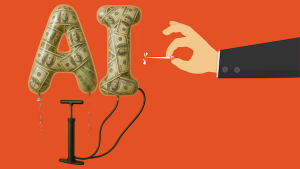On July 18, 2025, the President Trump signed into law the ‘‘Guiding and Establishing National Innovation for U.S. Stablecoins Act” (GENIUS Act). The GENIUS Act – despite its Orwellian sobriquet – is a profoundly misguided law that creates enormous dangers for our financial system, economy, and society. The GENIUS Act authorizes nonbanks to issue uninsured stablecoins to the public without the essential safeguards provided by federal deposit insurance and the prudential regulations governing FDIC-insured banks. In addition, the GENIUS Act gives federal and state regulators broad authority to allow nonbank stablecoin issuers to sell highly-leveraged crypto derivatives and other speculative crypto investments to the public.
As shown below, the GENIUS Act plants the seeds for a crypto-fueled “Subprime 2.0” financial crisis that could be even worse than the global financial crisis of 2007-09. The GENIUS Act places the federal government’s seal of approval on uninsured and weakly-regulated nonbank stablecoins as well as hazardous crypto derivatives. By doing so, the GENIUS Act has greatly increased the likelihood that future runs on stablecoins and fire sales of crypto derivatives will trigger systemic crises in our financial markets that have devastating spillover effects on our economy.
The GENIUS Act also opens the door for Big Tech firms and other commercial enterprises to issue and distribute stablecoins and conduct a crypto-based banking business. Allowing commercial and technology giants to offer stablecoins and other risky crypto investments will greatly increase the risk that future crypto crashes will engulf our entire economy. In view of the federal government’s massive debt burden and rapidly rising debt service costs, it is extremely doubtful whether federal agencies could arrange another set of comprehensive bailouts without triggering a sovereign debt crisis.
To remove the intolerable threats posed by uninsured nonbank stablecoins and crypto derivatives, Congress should repeal the GENIUS Act and pass legislation requiring all issuers and distributors of stablecoins to be FDIC-insured banks. Congress should also pass legislation requiring crypto derivatives to comply with the prudential rules established by Title VII of the Dodd-Frank Act for non-digital derivatives.
Uninsured nonbank stablecoins are highly vulnerable to investor runs, which the GENIUS Act will not prevent.
A stablecoin is a crypto-asset whose issuer represents that the stablecoin’s value will maintain parity with a designated fiat currency or some other referenced asset or group of assets. About 98% of global stablecoins are linked (“pegged”) to the U.S. dollar. Dollar-linked stablecoins are functionally equivalent to bank deposits because their issuers represent that their stablecoins will be redeemed or transferred to third parties, on a dollar-for-dollar basis, on their holders’ demand or within a specified time.
The global stablecoin market is highly concentrated. Tether’s USDT and Circle’s USDC account for over 80% of the $300 billion market capitalization of all global stablecoins. Stablecoins are primarily used as payment instruments for speculating in crypto-assets with fluctuating values, with about 90% of stablecoin payments being linked to crypto trades.
Stablecoins are also widely used for conducting illicit transactions. In 2023, stablecoins were used as payment instruments for 60% of unlawful cryptocurrency transactions (including crypto scams, ransomware, evasion of capital controls, money laundering, and tax evasion) and 80% of all cryptocurrency transactions conducted by sanctioned regimes and terrorist groups.
Dollar-linked stablecoins are used to a limited extent for cross-border remittances and other types of conventional payments, especially in developing countries with high inflation rates, unstable currencies, and unreliable banking and payment systems. In those countries, dollar-linked stablecoins provide a more stable form of currency, a more secure form of payment, and a hedge against inflation. At present, however, only 6% of stablecoin transactions involve cross-border remittances and other types of conventional payments. In addition, some governments view dollar-linked stablecoins as a threat to their monetary sovereignty and are considering measures to ban or limit the use of dollar-linked stablecoins in their countries.
Despite the promises made by stablecoin issuers, stablecoins have proven to be anything but stable. More than 20 stablecoins collapsed between 2016 and 2022, and every leading global stablecoin – including USDT and USDC – lost its “peg” on multiple occasions between 2019 and 2023.
Nonbank stablecoins are inherently unstable due to their primary use as “casino chips” for trading (gambling) in crypto-assets with fluctuating values. Bitcoin, Ethereum, and other fluctuating-value crypto-assets have displayed huge price swings because they do not have any substantial underlying real-world assets, and they do not generate independent cash flows from activities beyond the speculative transactions occurring on their blockchains. Prices for crypto-assets with fluctuating values have experienced pronounced boom-and-bust cycles, including the crypto boom of 2020-21, the “crypto winter” of 2021-22, a slow recovery during 2022-23, and a second crypto boom that began in 2024, interrupted by a brief downturn during the first quarter of 2025.
When values for crypto-assets fall significantly, highly-leveraged investors must liquidate their crypto holdings (including stablecoins) to meet margin calls and other debt obligations. The global market value of outstanding stablecoins dropped from $180 billion to $130 billion during the “crypto winter” of 2021-22, when the price of Bitcoin and the total market capitalization of all crypto-assets dropped by 70%. When large numbers of investors are suddenly obliged to liquidate their stablecoins, they must rely on the ability of stablecoin issuers and stablecoin exchanges to redeem stablecoins quickly at the “pegged” value of $1 per coin.
The GENIUS Act permits nonbank stablecoin issuers to hold all or most of their reserves in uninsured financial instruments, such as uninsured bank deposits, money market funds (MMFs), and repurchase agreements (repos). Those uninsured reserves make nonbank stablecoin issuers vulnerable to serious disruptions in traditional financial markets. When Silicon Valley Bank (SVB) failed during the regional banking crisis of 2023, SVB’s largest uninsured depositor turned out to be Circle, which held $3.3 billion (8%) of USDC’s reserves at SVB. USDC broke its $1 “peg” after SVB failed, and its value fell to $0.87. USDC’s stablecoin holders launched a major run, and Circle was forced to liquidate $8 billion of its assets to satisfy redemption demands. USDC avoided a complete collapse – which could have caused a systemic meltdown in crypto markets – only after federal regulators invoked the systemic risk exception in the Federal Deposit Insurance Act and bailed out Circle and SVB’s other uninsured depositors. The federal government’s rescue of Circle represented the first government bailout of uninsured nonbank stablecoins.
As SEC Commissioner Caroline Crenshaw observed in April 2005, “there is always a risk, particularly in times of market stress or if the price of a stablecoin drops, of a ‘run’ scenario” where crypto exchanges and stablecoin issuers “cannot honor all redemption requests in real time,” triggering a “self-reinforcing cycle of redemptions and fire sales of reserve assets.” The runs that have already occurred on nonbank stablecoins resemble the runs on uninsured deposits, MMFs, repos, and other uninsured, short-term financial claims that have taken place during U.S. financial crises stretching from the nineteenth century through 2023.
The federal government rescued uninsured depositors in 1980-92, 2008-09, and 2023 to prevent banking and financial crises from becoming full-blown economic depressions. For similar reasons, the federal government protected investors in MMFs and other uninsured short-term financial instruments (such as commercial paper and repos) during the global financial crisis of 2008-09 and the pandemic financial crisis of 2020-21.
The foregoing crises demonstrate that uninsured nonbank stablecoins, like other uninsured, short-term financial claims, are highly vulnerable to investor runs whenever there are substantial doubts about the ability of obligors to repay those financial claims in a timely manner. The GENIUS Act ignores the lessons of history because (1) it establishes a very weak and woefully inadequate regulatory regime for stablecoins, (2) it fails to provide a federally-supervised insurance fund or a federally-authorized lender of last resort to ensure the timely repayment of stablecoins, and (3) its only mechanism for dealing with defaults by stablecoin issuers is a deeply flawed bankruptcy regime, which will encourage stablecoin holders to run at the first sign of trouble.
The GENIUS Act will not improve our payments system or increase financial inclusion.
Crypto advocates claim that uninsured nonbank stablecoins will greatly improve the U.S. payments system and increase financial inclusion. In fact, nonbank stablecoins operating on permissionless public blockchains do not offer a viable technology for providing fast, reliable, and cost-effective general-purpose payments or other large-volume financial services. Permissionless public blockchains suffer from two major problems – lack of scalability (the inability to process large numbers of transactions quickly) and immutability (the inability to correct mistaken, fraudulent, and unauthorized transactions). Those two problems – which arise out of the basic tenets of public blockchains – prevent public blockchains from providing a feasible technology for high-volume financial services.
To mitigate the scalability problem, public blockchains have used “Layer 2” strategies such as sidechains and off-chain processing. “Layer 2” strategies delegate responsibility for processing and validating transactions to designated groups, which transmit the results of their work to the public blockchain. Such delegations of responsibility to trusted parties cause public blockchains to resemble permissioned distributed ledgers, which are administered by banks, broker-dealers, clearing facilities, and other traditional financial institutions.
When public blockchains change their operations to function like permissioned ledgers, they effectively become financial intermediaries, and there is no longer any possible justification for regulating them differently from traditional financial intermediaries. As SEC Commissioner Crenshaw pointed out in January 2024, “If [public blockchain] technology is so revolutionary, why do so many of its uses seem to revolve around recreating the existing financial system, except with less regulation, more opacity, fewer investor protections, and more risk?”
In addition to their unsuitability for general-purpose payments, nonbank stablecoins have not shown any ability to increase financial inclusion. Stablecoin holders must open bank accounts to convert their fiat currency into stablecoins, and to convert their stablecoins back into fiat currency. Stablecoin holders must also have internet access and financial sophistication, which many “unbanked” households lack. The crypto industry’s past dealings with underserved communities have included widespread predatory practices, including fraudulent marketing of high-risk crypto-assets and “crypto ATMs” that charge high fees and are widely used to promote crypto scams.
If Congress truly wants to promote a faster, cheaper, and more inclusive payments system, Congress should pass legislation that would (i) support tokenization of deposits on permissioned distributed ledgers administered by FDIC-insured banks, (ii) encourage faster implementation of real-time settlement services for bank payments, and (iii) require FDIC-insured banks to provide low-cost “Bank On” deposit accounts with payment services to lower-income individuals and families who satisfy minimum qualifications for lawful status and financial responsibility. Such legislation would promote much-needed improvements in our payments system and increase financial inclusion without undermining the integrity and effectiveness of our federally-insured banking system.
The GENIUS Act creates a “Shadow Banking 2.0” crypto regime and unleashes crypto derivatives that will inflate a “Subprime 2.0” crypto bubble.
The GENIUS Act allows uninsured nonbank stablecoins to become a dangerous new form of “shadow deposits” comparable to MMFs, thereby creating a dangerous “Shadow Banking 2.0” crypto regime. Nonbank stablecoin issuers will siphon away large amounts of deposits from FDIC-insured banks because the GENIUS Act permits affiliates of stablecoin issuers and crypto exchanges to pay “rewards” on stablecoins. The loss of bank deposits will severely impair the ability of community and regional banks to provide much-needed loans to consumers and Main Street businesses. Nonbank stablecoin issuers cannot replace those lost loans because they must invest virtually all their assets in designated short-term financial instruments held as reserves.
The GENIUS Act also permits nonbank stablecoin issuers to sell to the public a potentially unlimited range of crypto derivatives and other crypto investments that are approved by federal and state regulators as being “incidental” to the activities of crypto asset service providers. Crypto derivatives – including futures, options, and swaps – account for about three-quarters of all crypto trading activity, and most crypto derivatives trades occur on unregulated foreign exchanges. Perpetual crypto futures contracts enable investors to make highly-leveraged, long-term bets on movements in crypto prices without owning the underlying crypto-assets.
In addition, SEC has approved crypto exchange-traded funds (ETFs) that track the value of both individual and multiple crypto-assets. Crypto ETFs are rapidly proliferating, as are “crypto treasury companies” that invest in crypto-assets. The explosion of high-risk crypto derivatives and other risky crypto investments is inflating a “Subprime 2.0” crypto bubble by generating multiple, highly-leveraged bets on extremely volatile crypto-assets that do not have any underlying tangible assets or independent cash flows. The rapidly growing pile of speculative bets on crypto-assets resembles the toxic pyramid of bets on subprime mortgages, which financial giants created during the “Subprime 1.0” credit boom of the 2000s by issuing trillions of dollars of derivatives whose values depended on the performance of subprime mortgages.
The collapse of the “Subprime 1.0” credit boom in 2007 unleashed a global financial crisis. The bursting of the speculative crypto bubble produced by “Shadow Banking 2.0” and “Subprime 2.0” will almost certainly cause a similar crash, with potentially devastating spillover effects on our financial system and economy. Federal agencies will be very hard-pressed to contain such a crash with bailouts comparable to those of 2008-09 and 2020-21. Given the federal government’s huge debt burden, implementing such bailouts would be likely to trigger a crisis in the Treasury bond market as well as a significant depreciation of the U.S. dollar.
The GENIUS Act opens the door for Big Tech firms and other commercial enterprises to conduct a crypto banking business, magnifying the risks of the current crypto bubble.
Under the GENIUS Act, Big Tech firms and other commercial enterprises can acquire nonbank stablecoin issuers and use those issuers’ funds and services to establish crypto-based financial empires. Alphabet (Google), Amazon, Apple, Meta (Facebook), Walmart, and X are already developing plans to offer stablecoins. The GENIUS Act allows privately-held technology firms, like Elon Musk’s X, to acquire nonbank stablecoin issuers. The statute also permits the “Stablecoin Certification Review Committee,” chaired by Treasury Secretary Bessent, to authorize publicly-traded Big Tech firms and other commercial enterprises to acquire nonbank stablecoin issuers.
The GENIUS Act undermines our nation’s long-established policy of separating banking and commerce and creates enormous risks for consumers and Main Street businesses. Allowing Big Tech firms to issue and distribute stablecoins will give technology giants access to their customers’ private financial data, including detailed information about their financial assets and spending patterns. That access will increase exponentially the ability of Big Tech firms to surveil, sell, and monetize their customers’ private information.
Acquisitions of stablecoin issuers by Big Tech firms and other commercial enterprises will create a new category of “too-big-to-fail” financial giants. Those acquisitions will also greatly increase the likelihood that future crypto crashes will spread across the entire span of our economy, inflicting catastrophic losses on our financial system, economy, and society.
Conclusion
The GENIUS Act is a disastrous law that poses grave and unacceptable threats to our financial and economic future. Congress must remove those threats by (1) repealing the GENIUS Act and passing legislation that requires all stablecoin providers to be FDIC-insured banks, and (2) adopting legislation that requires all crypto derivatives to comply with the rules governing non-digital derivatives under Title VII of the Dodd-Frank Act.



